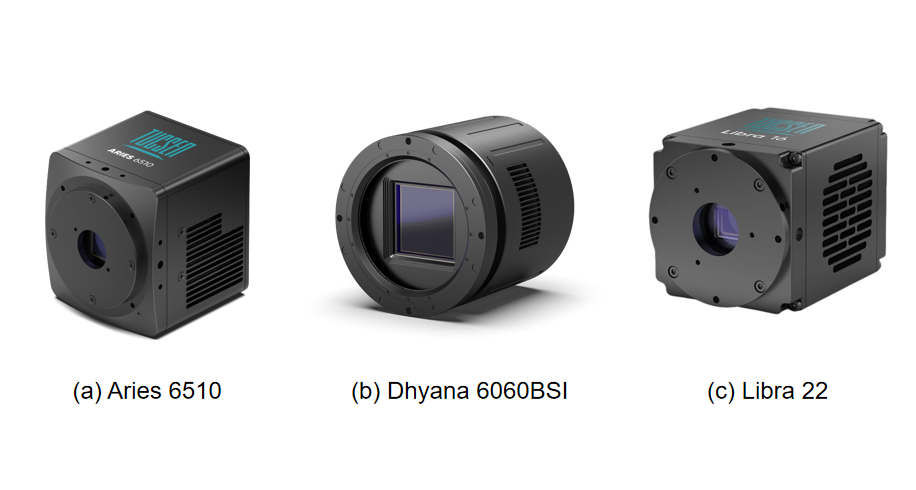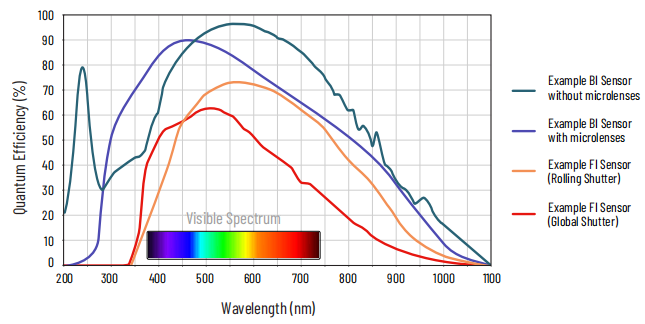In scientific imaging, precision is everything. Whether you're capturing low-light fluorescence signals or tracking faint celestial objects, your camera's ability to detect light directly influences the quality of your results. One of the most critical, but often misunderstood, factors in this equation is quantum efficiency (QE).
This guide will walk you through what QE is, why it matters, how to interpret QE specifications, and how it compares across sensor types. If you're in the market for a scientific camera or just trying to make sense of camera datasheets, this is for you.

Figure: Tucsen typical camera QE curve examples
(a) Aries 6510 (b) Dhyana 6060BSI (c) Libra 22
What Is Quantum Efficiency?
Quantum Efficiency is the likelihood of a photon that reaches the camera sensor actually being detected, and releasing a photoelectron in the silicon.
At multiple stages in the photon’s journey towards this point, there are barriers that can absorb photons or reflect them away. Additionally, no material is 100% transparent to every photon wavelength, plus any changes in material composition have a chance of reflecting or scattering photons.
Expressed as a percentage, quantum efficiency is defined as:
QE (%) = (Number of electrons generated / Number of incident photons) × 100
There are two main types:
● External QE: Measured performance including effects like reflection and transmission losses.
● Internal QE: Measures conversion efficiency within the sensor itself, assuming all photons are absorbed.
Higher QE means better light sensitivity and stronger image signals, especially in low-light or photon-limited scenarios.
Why Does Quantum Efficiency Matter in Scientific Cameras?
In imaging, it is always helpful to capture the highest percentage of incoming photons that we can, especially in applications demanding high sensitivity.
However, high quantum efficiency sensors tend to be more expensive. This is due to the engineering challenge of maximizing fill factor while maintaining pixel function, and also due to the back illumination process. This process, as you’ll learn, enables the highest quantum efficiencies—but it comes with significantly increased manufacturing complexity.
Like all camera specifications, the need for quantum efficiency must always be weighed against other factors for your specific imaging application. For example, introducing a global shutter can bring advantages for many applications, but typically cannot be implemented on a BI sensor. Further, it requires the addition of an extra transistor to the pixel. This can reduce fill factor and hence quantum efficiency, even compared to other FI sensors.
Example applications where QE can be important
A few example applications:
● Low light & fluorescence imaging of non-fixed biological samples
● High-speed imaging
● Quantitative applications requiring high precision intensity measurements
QE by Sensor Type
Different image sensor technologies exhibit different quantum efficiencies. Here’s how QE typically compares across major sensor types:
CCD (Charge-Coupled Device)
Traditionally favored scientific imaging for their low noise and high QE, often peaking between 70–90%. CCDs excel in applications like astronomy and long-exposure imaging.
CMOS (Complementary Metal-Oxide-Semiconductor)
Once limited by lower QE and higher read noise, modern CMOS sensors—especially back-illuminated designs—have caught up significantly. Many now reach peak QE values above 80%, offering excellent performance with faster frame rates and lower power consumption.
Explore our range of advanced CMOS camera models to see how far this technology has come, like Tucsen's Libra 3405M sCMOS Camera, a high-sensitivity scientific camera designed for demanding low-light applications.
sCMOS (Scientific CMOS)
A specialized class of CMOS designed for scientific imaging, sCMOS camera technology combines high QE (typically 70–95%) with low noise, high dynamic range, and fast acquisition. Ideal for live-cell imaging, high-speed microscopy, and multi-channel fluorescence.
How to Read a Quantum Efficiency Curve
Manufacturers typically publish a QE curve that plots efficiency (%) across wavelengths (nm). These curves are essential for determining how a camera performs in specific spectral ranges.
Key elements to look for:
● Peak QE: The maximum efficiency, often in the 500–600 nm range (green light).
● Wavelength Range: The usable spectral window where QE remains above a useful threshold (e.g., >20%).
● Drop-off Zones: QE tends to fall off in the UV (<400 nm) and NIR (>800 nm) regions.
Interpreting this curve helps you match the sensor’s strengths with your application, whether you're imaging in the visible spectrum, near-infrared, or UV.
Wavelength Dependence of Quantum Efficiency

Figure: Quantum efficiency curve showing typical values for front- and back-illuminated silicon-based sensors
The graph shows likelihood of photon detection (quantum efficiency, %) versus photon wavelength for four example cameras. Different sensor variants and coatings can shift these curves dramatically
Quantum efficiency is highly wavelength dependent, as shown in the figure. The majority of silicon-based camera sensors exhibit their peak quantum efficiency in the visible part of the spectrum, most commonly in the green to yellow region, from around 490nm to 600nm. QE curves can be modified through sensor coatings and material variants to provide peak QE around 300nm in the ultra-violet (UV), around 850nm in the near infra red (NIR), and many options between.
All silicon-based cameras exhibit a decline in quantum efficiency towards 1100nm, at which photons no longer have enough energy to release photoelectrons. UV performance can be severely limited in sensors with microlenses or UV-blocking window glass, which restrict short-wavelength light from reaching the sensor.
In between, QE curves are rarely smooth and even, and instead often include small peaks and troughs caused by the different material properties and transparencies of the materials the pixel is composed of.
In applications requiring UV or NIR sensitivity, considering quantum efficiency curves can become much more important, as in some cameras quantum efficiency can be many times larger than others at the extreme ends of the curve.
X-ray Sensitivity
Some silicon camera sensors can operate in the visible light part of the spectrum, while also being capable of detecting some wavelengths of X-rays. However, cameras usually require specific engineering to cope both with the impact of X-rays onto camera electronics, and with the vacuum chambers generally used for X-ray experiments.
Infrared Cameras
Finally, sensors based not on silicon but on other materials can exhibit completely different QE curves. For example, InGaAs infrared cameras, based upon Indium Gallium Arsenide in place of silicon, can detect broad wavelength ranges in the NIR, up to a maximum of around 2700nm, depending upon the sensor variant.
Quantum Efficiency vs. Other Camera Specs
Quantum efficiency is a key performance metric, but it doesn't operate in isolation. Here’s how it relates to other important camera specifications:
QE vs. Sensitivity
Sensitivity is the camera’s ability to detect faint signals. QE contributes directly to sensitivity, but other factors like pixel size, read noise, and dark current also play a role.
QE vs. Signal-to-Noise Ratio (SNR)
A higher QE improves SNR by generating more signal (electrons) per photon. But excessive noise, due to poor electronics or inadequate cooling, can still degrade the image.
QE vs. Dynamic Range
While QE affects how much light is detected, dynamic range describes the ratio between the brightest and darkest signals the camera can handle. A high QE camera with poor dynamic range can still produce subpar results in high-contrast scenes.
In short, quantum efficiency is critical, but always evaluate it alongside complementary specs.
What Is a "Good" Quantum Efficiency?
There's no universal "best" QE—it depends on your application. That said, here are general benchmarks:
|
QE Range |
Performance Level |
Use Cases |
|
<40% |
Low |
Not ideal for scientific use |
|
40–60% |
Average |
Entry-level scientific applications |
|
60–80% |
Good |
Suitable for most imaging tasks |
|
80–95% |
Excellent |
Low-light, high-precision, or photon-limited imaging |
Also, consider peak QE vs average QE across your desired spectral range.
Conclusion
Quantum efficiency is one of the most important, yet overlooked, factors in selecting a scientific imaging device. Whether you're evaluating CCDs, sCMOS cameras, or CMOS cameras, understanding QE helps you:
● Predict how your camera will perform under real-world lighting conditions
● Compare products objectively beyond marketing claims
● Match camera specs with your scientific requirements
As sensor technology advances, today’s high-QE scientific cameras offer remarkable sensitivity and versatility across diverse applications. But no matter how advanced the hardware, choosing the right tool starts with understanding how quantum efficiency fits into the bigger picture.
FAQs
Is higher quantum efficiency always better in a scientific camera?
Higher quantum efficiency (QE) generally improves a camera’s ability to detect low levels of light, which is valuable in applications like fluorescence microscopy, astronomy, and single-molecule imaging. However, QE is just one part of a balanced performance profile. A high-QE camera with poor dynamic range, high read noise, or insufficient cooling may still deliver suboptimal results. For the best performance, always evaluate QE in combination with other key specs like noise, bit depth, and sensor architecture.
How is quantum efficiency measured?
Quantum efficiency is measured by illuminating a sensor with a known number of photons at a specific wavelength and then counting the number of electrons generated by the sensor. This is typically done using a calibrated monochromatic light source and a reference photodiode. The resulting QE value is plotted across wavelengths to create a QE curve. This helps determine the sensor's spectral response, critical for matching the camera to your application’s light source or emission range.
Can software or external filters improve quantum efficiency?
No—quantum efficiency is an intrinsic, hardware-level property of the image sensor and cannot be altered by software or external accessories. However, filters can improve overall image quality by enhancing signal-to-noise ratio (e.g., using emission filters in fluorescence applications), and software can help with noise reduction or post-processing. Still, these do not change the QE value itself.
Tucsen Photonics Co., Ltd. All rights reserved. When citing, please acknowledge the source: www.tucsen.com


 2025/09/30
2025/09/30







